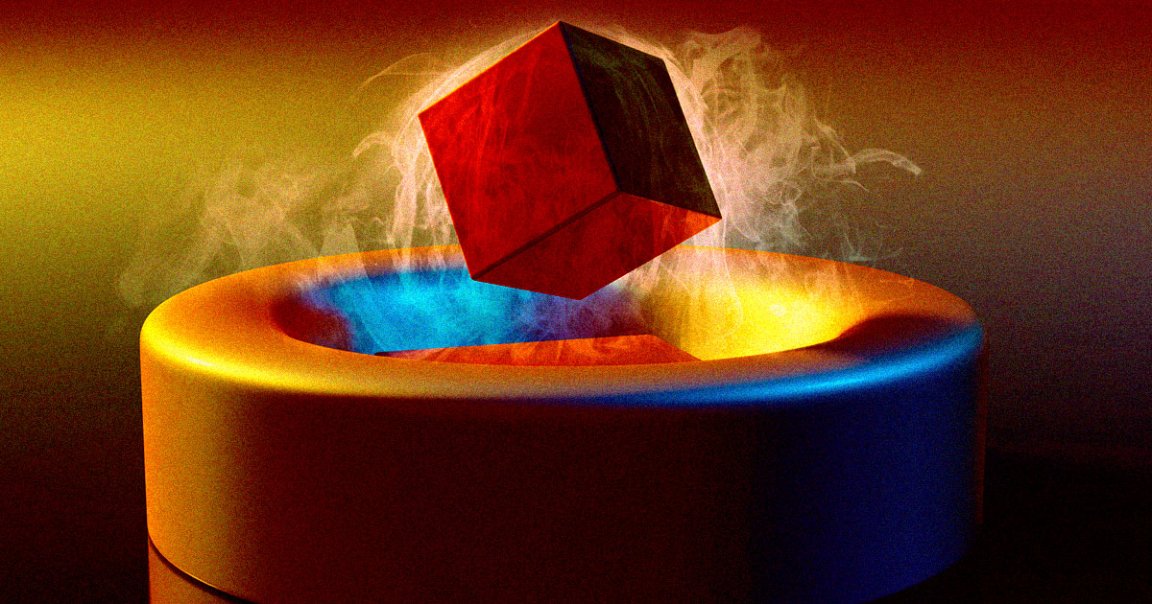
Last month, a team of researchers claimed they’d essentially found the holy grail in the field of physics: a superconductor that can operate at ambient pressures and room temperatures.
That’s a huge claim, so the pair of yet-to-be-peer-reviewed papers have drawn a huge amount of attention in scientific circles. Superconductors typically require ultra-low temperatures and extremely high pressures to achieve perfect conductivity, and the discovery of one that could operate at higher temperatures — up to about 260 degrees Fahrenheit, in fact — could be a bona fide breakthrough.
According to the researchers, the material — dubbed LK-99 — can conduct electricity without any resistance up to that temperature, a potentially revolutionary finding that could lead to incredible advancements in energy transportation, magnetic levitation, quantum computing, or even nuclear fusion.
The news even triggered huge superconductor-related stock bumps this week, to the point that the Korea Exchange issued warnings to investors, but stopped short of halting trading, Bloomberg reports.
In short, it’s a huge deal — if it holds up. So it’s no wonder that scientists are now stumbling over themselves to recreate the material.
And the drama is only getting started. This week, more researchers have come forward claiming to have proven the material’s existence and miraculous properties — but not everybody is convinced, creating a striking public schism in the world of physics. Is everybody racing to take credit for a discovery of the century and bag a Nobel prize — or is it a colossal fool’s errand?
Last month, a research team led by William & Mary University physics researcher Hyun Tak Kim presented evidence for the new material. Its electrical resistance allowed the object to levitate on a permanent magnet — without first being cooled down to extremely low temperatures. Even the best-performing current superconductor has to be cooled down to a frosty -220 degrees Fahrenheit.
The preprint was submitted to the preprint arXiv on the very same day as an entirely separate preprint by a different group of South Korean researchers who made eerily similar claims.
But there’s one problem: other scientists who’ve been reviewing the research aren’t convinced.
The news was met with skepticism, for instance, by Pablo Esquinazi, the head of the Division of Quantum Magnetism and Superconductivity at the University of Leipzig, who told Vice that “it is really frustrating! With such a title I thought that it should be something serious, but it does not seem so.”
“I take [the announcement] with the proverbial grain of salt, though this particular grain seems closer to the size of a rock,” Jens Koch, a professor of physics at Northwestern University, told The Daily Beast. “This is an area of research where breakthrough claims have been made in the past and then had to be retracted because they did not hold up under scrutiny.”
Indeed, previous claims of room-temperature superconductors have led to plenty of scrutiny and even retractions.
Others called for everybody to relax until the scientific community had time to review the evidence.
“I think this is attracting more attention than it probably warrants until there is independent verification,” James Hamlin, an associate professor at the University of Florida, told Vice.
That hasn’t stopped scientists from racing to recreate the purported wonder-material in their own labs to varying degrees of success — or so they claim.
“The experimental preparation of LK-99 was not very complicated at all, though, and did not use any particularly exotic materials or equipment, so the expectation was that many labs would immediately try to reproduce it,” chemist Derek Lowe wrote in a commentary piece for Science.
Videos circulating on social media by Chinese researchers with the Huazhong University of Science and Technology appear to show a tiny sample of the purported material hovering above a magnet.
But a video doesn’t exactly amount to watertight scientific proof of its existence. For instance, some experts have argued that the demonstrated Meissner effect in the video could simply be evidence that the tiny sample is diamagnetic or able to repel magnetic fields — but not a superconductor that can fully levitate on top of a magnet.
“I will be very happy if this is a real replication, but I’m not taking the day off yet to celebrate just based on this,” Lowe wrote referring to the video, concluding that he was “guardedly optimistic at this point.”
So where do we go from here? The story will likely change day by day and at least one of the two recently shared preprints is being prepared to be submitted to a peer-reviewed journal, according to Lowe.
“It may be a while before we understand what has actually been going on behind the scenes, but honestly, I can’t blame anyone for some excitability and confusion,” he wrote.
“If I’d been in on the discovery of a room-temperature superconductor I would have surely gone into Headless Poultry Mode myself,” Lowe added.
More on superconductors: Researchers Say They’ve Created Superconductors At Room Temperature